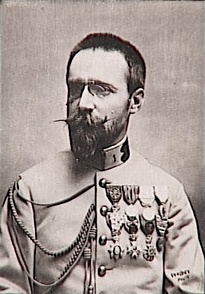Loading AI tools
French military officer (1858–1900) From Wikipedia, the free encyclopedia
Amédée-François Lamy (French pronunciation: [amede fʁɑ̃swa lami]) was a French military officer. He was born at Mougins, in the French département of Alpes-Maritimes on 7 February 1858 and died in the battle of Kousséri on 22 April 1900 as a French explorer officer.
This article includes a list of references, related reading, or external links, but its sources remain unclear because it lacks inline citations. (February 2022) |
Amédée-François Lamy | |
|---|---|
 | |
| Born | 7 February 1858 Mougins, Alpes-Maritimes, France |
| Died | 22 April 1900 (aged 42) Kousséri |
| Nationality | French |
| Occupation | French commander Major |
| Known for | Battle of Kousséri |
He is the son of lieutenant Joseph Sosthène Lamy (1818–1891), originally from Nancy, and of Elisabeth Giraud, from an old and notable Provençal family, whose father Louis Giraud, notary, had married Honorine Courmes, from Grasse, the latter was the daughter of Claude-Marie Courmes, mayor of Grasse from 1830 to 1835.[1]
Lamy's ambition to become an officer developed very early; at ten-years-old, he entered the Prytanée national militaire, where he won the first prize in Geography in the general concourse of all the department's school, a possible sign of his future colonial career. In 1877 he entered at Saint-Cyr, the foremost French military academy.


Lamy began his career in 1879 as a second lieutenant in the First regiment of Algerian tirailleurs. He discovered Saharan Africa, and took part in the French occupation of Tunisia; he was sent in 1884 to Tonkin, where he remained until 1886. The following year he was back in Algeria, where he became aide-de-camp to the General in command of the division quartered in Algiers in 1887, and resumed his previous interest in the Sahara and learned to exploit the qualities of the méharistes, the camel cavalry. Fascinated by the desert, he learned how to live with little: "Personally, I will be really happy only when I'll be able to live without neither drinking nor eating. At the moment, I'm attempting this kind of existence, but obtaining only a meagre success. I'm still obliged to eat more than six dates at my meals: this is afflicting!". In 1893 Lamy participated in the Le Chatelier Mission (Middle Congo) where he was in charge of studying the project of a railway between Brazzaville and the coast, and also of making botanical, geological and geographical studies. Through Alfred Le Chatelier, Lamy later met Fernand Foureau, with whom he assembled the Foureau-Lamy Mission in 1898, charged, with another two expeditions, the Gentil and Voulet–Chanoine missions, to conquer Chad and unify all French dominions in West Africa.

Foureau and Lamy proceeded from Algiers through the Sahara, and met with the other two missions at Kousséri on 21 April 1900. The following day the united French forces confronted Rabih az-Zubayr, a Sudanese warlord who had created an empire in the Chad Basin. In the following battle, in which Lamy was in command with 700 riflemen, while the French reported a crushing victory, Lamy was killed, as was Rabih. In his honour, the first French governor, Émile Gentil, named the capital of the new French territory of Chad Fort-Lamy, which name it bore until it was renamed N'Djamena in 1973.
In 1970, Chad issued an undated gold 1,000 francs coin as part of its tenth independence celebrations. One side features Lamy's head, with a military style collar, and the legend COMMANDANT LAMY 1900.
There is a Lamy barracks in Longuyon 54
Seamless Wikipedia browsing. On steroids.
Every time you click a link to Wikipedia, Wiktionary or Wikiquote in your browser's search results, it will show the modern Wikiwand interface.
Wikiwand extension is a five stars, simple, with minimum permission required to keep your browsing private, safe and transparent.